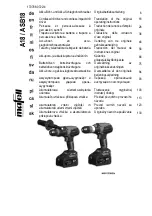
Disposal of ashes – Ashes should be placed in a metal container with a tight-fitting lid.The closed
cotainer of ashes should be placed on a non-combustible floor or on the ground,well away from all
combustible materials,pending final disposal. When the ashes are disposed by burial in soil or
otherwise locally dispersed, they should be retained in the closed container until all cinders have
thoroughly cooled.
Remove pots and pans while the operating appliance is unattended, to reduce the risk of fire.
Do not use accessories not specified for use with this appliance.
Use grounding receptacle that complies with the local safety regulations. If the receptacle needs to be
reinstalled, please follow local electrical specification.
Dangerous voltage will cause shock, burn or death. In case of device failure,please follow
the prompt of the instruction or contact local customer service.Unplug from power before
maintenance.
There will be high temperature in local positions in the use of the device, please do not
move the device casually and take care of the old and children and beware of burn.
Follow these guidelines to prevent this colorless , odorless gas from poisoning you, your
family or others.
Know the symptoms of carbon monoxide poisoning : headache , dizziness, weakness, nausea,
vomiting , sleepiness , and confusion.Carbon monoxide reduces the blood’s ability to carry oxygen.
Low blood oxygen levels can result in loss of consciousness and death.
See a doctor if you or others develop cold or flu-like symptoms while cooking or in the
vicinity of this appliance. Carbon monoxide poisoning, which can easily be mistaken for a
cold or flu, is often detected too late.
Alcohol consumption and drug use increase the effects of carbon monoxide poisoning.
Carbon monoxide is especially toxic to mother and child during pregnancy ,infants ,the elderly,
smokers ,and people with blood or circulatory system problems ,such as anemia ,or heart disease.
Creosote – Formation and need for removal. When wood pellets are burned slowly,
they produce tar and other organic vapors that combine with expelled moisture to form
creosote.The creosote vapors condense in a relatively cool oven flue and exhaust hood of
a slow burning fire. As a result, creosote residue accumulates on the flue lining and exhaust
hood.When ignited,this creosote makes an extremely hot fire.
The grease duct should be inspected at least twice a year to determine when grease and/
or creosote buildup has occurred.
When grease or creosote has accumulated, it should be removed to reduce risk of fire.
Do not burn for a long time to prevent the product from overheating.
3
Safety Warning
Summary of Contents for 85030
Page 5: ...Model 85030 Parts Diagram 5 ...
Page 7: ...7 A 8PCS B 4PCS A 8PCS C 4PCS H 8PCS ...
Page 8: ...F 1PC 8 ...
Page 9: ...B 12PCS C 12PCS D D E E A A D 2PCS E 2PCS A 2PCS B 2PCS B B 9 ...
Page 10: ...D E D E A A D 2PCS E 2PCS A 2PCS G 2PCS 10 ...
Page 11: ...A 2PCS 11 ...
Page 12: ...12 ...
Page 13: ...B 4PCS A 8PCS C 4PCS K 8PCS 13 ...
Page 14: ...1 2 G 2PCS 14 ...
Page 15: ...15 ...




































